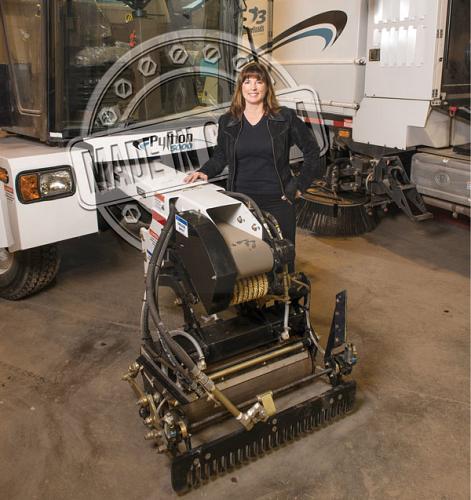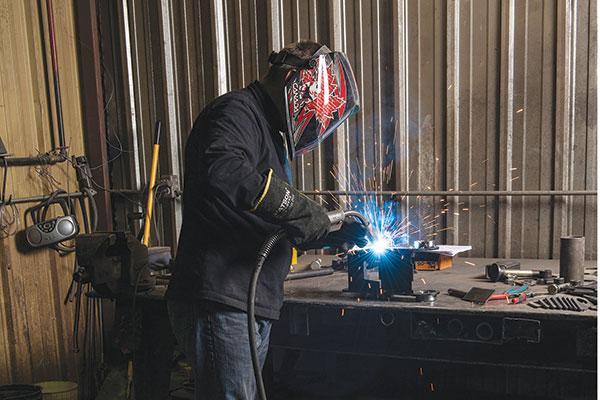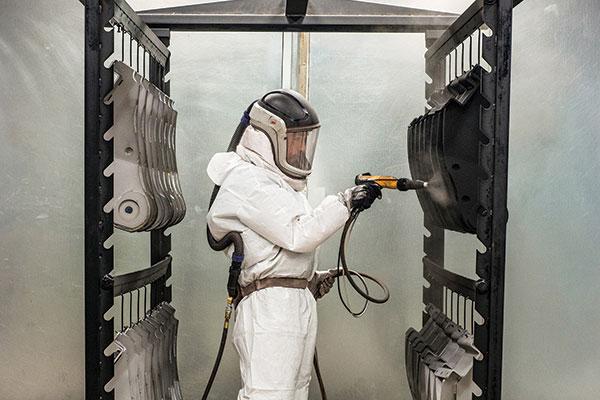Potholes and Debris-Beware!
SuperiorRoads Solutions manufactures vehicles to smooth the way and tidy up
CANADIAN INDUSTRIAL MACHINERY JANUARY 2015
JANUARY 5, 2015
Regina-based manufacturer is developing a new pothole patcher to meet regulations for oversea sales.
Heather Forbes, president of SuperiorRoads Solutions, Regina, Sask., stands by the tool-equipped arm of the company’s Python 5000 pothole patcher.
One of the products Superior- Roads Solutions manufactures in its Regina, Sask., plant becomes especially popular when the snow and ice melt off the roads to reveal potholes, craters, and cracks. Those craters and cracks can shake, rattle, and roll unsuspecting vehicles for several months if they are waiting to be repaired using traditional methods.
The Python 5000 pothole patchers that roll out of the plant turn those treacherous chasms into smooth, harmless surfaces. And they can safely, quickly, and economically make the repairs as soon as the road is free of snow.
Using a computer and joystick in the vehicle’s cab, one person controls an air nozzle that blasts away water, dust, gravel, and debris to clean the contact area; a sprayer to distribute emulsive tack oil to assist with asphalt adhesion; an auger system to move the asphalt mix from the 5-ton, vehicle-mounted hopper to the repair site; an adjustable V-rake that delivers the asphalt; and a finishing roller that compacts the repair material with about the same force as a 1-ton construction roller. The repair lasts as long as its surrounding pavement.
Most potholes and cracks can be repaired in about two minutes in any type of weather with the singleoperator vehicle. This replaces the typical, risky practice of sending out a three- to five-person crew with shovels and an asphalt hotbed truck to work on busy highways or narrow streets. The crews can be reserved to repair large potholes or those not easily reached by the Python 5000.
Building on a Solid Foundation
Innovative engineering, operator friendly operation, and safety have been built into Python vehicles since Les Hulicsko founded the business over 40 years ago. In 2012 the current management team, together with Golden Opportunities, a Saskatoon based venture capital fund, and Business Development Bank of Canada, recognized a good opportunity and purchased the company. Since then the name has changed to Superior- Roads Solutions and marketing efforts have been focused on putting the company’s vehicles on pothole riddled roads around the world.
Heather Forbes, SuperiorRoads president and CEO, talked about the transition. “Our plan is to grow on the good foundation put in place by Les, the previous owner who recently retired.
“We left the Python name on the pothole patchers because of its recognition but rebranded the company as SuperiorRoads to better represent what the company is about. The new name was launched at the APWA [American Public Works Association] show in Toronto last August.”
The shareholder group also purchased farm equipment manufacturer Rite Way Mfg. Co. Ltd., SuperiorRoads’ sister company located in Imperial, about an hour and a half away from Regina. The two companies share senior management. Research and development for both is done at the Regina location. Components for Rite Way equipment like rock pickers and windrowers join the roadworking vehicle assemblies that flow through the SuperiorRoads shop when production time allows.
Expanding Products and Markets
Welders in several gas metal arc welding cells create complex assemblies for SuperiorRoads vehicles and Rite Way farm equipment.
“The Python 5000 is a unique, patented product. There are competitors to the Python 5000 out there, but they do not have the same capabilities,” Forbes said. “The spray patchers, for example, make a different kind of repair that isn’t as durable. So we’re educating the market as we go.
“We’re also making some modifications to satisfy regulations in some new markets that we know have an interest in our vehicles. We are looking at reconfiguring the chassis to work with a different engine to meet standards for some European markets and California. The chassis will be larger, so we’ll be able to offer the option of a larger hopper. When the new design is complete, we’ll offer the current configuration and the new one.” The current hopper holds 5 tons of asphalt that is kept at the correct temperature by recycling the vehicle’s exhaust.
The prototype of the new pothole patcher is expected to be completed before spring, and the company is gearing up to meet production demands for the new model. Meantime, fleets of the current models have left the country to mend roads in Brazil and India.
Each vehicle is built to order. Customers choose from a long list of available customizations, including different types of hopper scales, GPSs, additional cameras, and different signal and warning lights. Two transmission speeds are available. The asphalt to be used—different countries use different types—can have an impact on how the vehicle is programmed and how some of the hopper equipment is put together. A sticky asphalt requires more hopper vibration to keep the asphalt flowing.
“A lot of customization is done through the computer,” Forbes said. “So if there has to be an adjustment made to accommodate a particular condition, we can do that here or remotely at their location.”
Cleaning the Streets
Sales of street sweepers, the second product line driven off the Superior- Roads assembly line, are also giving the company incentive to increase production capacity. “The recession of 2008 put cities off of buying sweepers. Now they are getting to the point where their sweepers can’t be repaired anymore so we are seeing more activity,” Forbes said.
The S3, the largest of the two sweeper models usually sold to large municipalities, is one of the most powerful in the industry. The smaller S2 is typically purchased by small towns, counties, and contractors.
“We believe that some sweeper controls like the broom pressure should be adjusted from the outside, where the operator can actually see what is happening, to get the best results,” said Forbes. “But some customers insist on being able to do everything from the cab, so we offer that as one of the options.” Tinted windows, extra work lights, a centralized lubrication system, and different mirrors can be part of a sweeper’s customization.
Implementing Lean Processes
The average time from order to shipment for a customized vehicle is 120 days. Each vehicle is built to order. The cabs, chassis, brooms for the sweepers, tanks for the pothole patcher, and hydraulics are purchased. Everything else is built and wired on-site.
At any time the product under construction in the company’s singlepiece- flow assembly line could be a sweeper, pothole patcher, or a rock picker for Rite Way.
Lean practices are being implemented in the welding, fabricating, and assembly departments to gear up for a heavier work load. Employees have embraced the 5S system and are measuring the results of their efforts.
“We are concentrating on making our facility more efficient and our production line more streamlined,” said Forbes. “We are upgrading equipment as needed to reconfigure our plant.”
An overhead conveyor was installed to carry parts and welded assemblies through the new finishing line. They travel through sandblasting and powder coating booths and a heat-treat oven.
“The main reason for the new line was to increase the finish quality. The powder coating is much less susceptible to rust when shipping overseas,” Forbes said. “But it has also resulted in considerable savings from recovering the sand and lower paint costs. There has also been an added benefit of better air quality.”
Finding the Right People
About 55 employees representing several nationalities keep Superior- Roads’ products moving. During the winter months, two shifts in the shop account for 40 employees. Production may be combined into one shift in summer months when some work can be done outside.
As in most areas of the country, recruiting qualified people can be challenging. At SuperiorRoads it involves a variety of methods, including recruiting trips to other countries, working with the government, and coordinating efforts with industry organizations.
“The Saskatchewan government has done a good job in setting up and funding apprenticeship programs to develop skilled labor. We also work through associations like the CME [Canadian Manufacturers & Exporters] that has a coordinated effort with community colleges,” said Forbes. “We’ve used the foreign worker program, and were just on a recruiting trip to Ireland.”
An overhead track moves assemblies through the new finishing line where they are sandblasted, powder-coated, and heat-treated.
A positive trend for the area’s workforce, Forbes pointed out, is that Saskatchewan used to export people to Alberta, but now people are staying put, many are returning, and the number of young people remaining in the area after graduation is increasing. Hopefully, a good percentage of those people are or will become skilled tradesmen.
“When we bought the company, we knew that the prospects were really good,” said Forbes. “We have a lot of tenders out there and we expect the business to grow. The need is there.”




